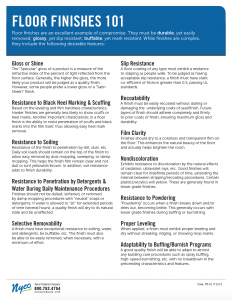
Finish Strong: How to Choose the Right Floor Finish for a Champion Caliber Program
Within seconds of entering a building the appearance of its floor will leave an impression of the level of care and cleanliness of the entire building. Like an accomplished athlete, a beautiful floor will be noticed and recognized. But creating and maintaining beautiful floors isn’t as easy as it looks. How do you build a champion-caliber floor care program that performs consistently? One key lies in learning how to choose the right floor finish.
When dry, a single coat of finish is thinner than a human hair. Yet commercial & public building floors must have enough protective coating to withstand the abuse of dirty shoes, snowy boots, sliding chairs, splashed water, spilled snacks, and thousands of footsteps! It’s a tall order that requires strategy, training, consistency, and most important, a properly formulated floor finish.
Nyco has been Building Better Floor Finishes Since 1920
Similar to the familiar 4 C’s used to characterize a diamond, floor finishes have attributes you can use to help evaluate and choose the right floor finish. Important are:
- Gloss – The shine or gloss level of a floor, which increases with each coat of finish you apply. There is a tool used to measure gloss and it’s called a gloss meter. Floors with a reading at or above 90, measured at a 60 degree angle with a gloss meter, are commonly considered to have “high gloss” and certain finishes have higher initial gloss than others.
- Hardness – A finish’s resistance to scratching and marking. Some finishes are more scratch and mark resistant than others.
- Durability – What is the longevity of the finish? How much foot traffic and other abuse can it withstand while still keeping its initial shine and beauty?
- Solids Content – The percent of solids indicates how much finish will remain on the floor after it dries. Higher solids finishes offer the benefit of labor savings because they require fewer coats.
These characteristics vary from product to product and brand to brand. A finish with an extremely high initial gloss may not be as durable, respond as well to buffing/burnishing, or be as scratch resistant as a finish with a lower initial gloss. A finish with extreme durability may not have a high initial gloss. Some finishes are best suited for procedures such as high speed buffing while others are best used in scrub and recoat applications. Download Nyco’s Floor Finishes 101 for a comprehensive list of finish attributes you may want to consider.
 How many coats exactly?
How many coats exactly?
As more coats of finish are applied, gloss and appearance will improve. A useful rule of thumb to determine how many coats you need is to divide 100 by the percent of solids in a finish. For example, if a finish contains 20% solids, divide 100 by 20 and you should apply 5 coats for optimal gloss and protection. If a finish contains 25% solids, divide 100 by 25 and you should lay down 4 initial coats.
What type of flooring do you have?
Most finishes are intended for use on specific types of flooring substrates such as vinyl, VCT, linoleum, quarry tile, stone or brick. Select appropriately.
Do you need a “green” finish?
Certain building such as those with LEED Green certification require the use of Green Certified finishes. If this is the case, your choices will be limited to finishes that meet these specifications, which may include VOC level considerations and exclusion of heavy metals.
Maintenance Procedures
Finishes must also be properly matched with the type and frequency of floor maintenance procedures in your program, like cleaning and buffing.
Cleaning
Automatic scrubbers clean faster and more effectively than the mop and bucket (manual) method. All finishes look better and last longer when matched with automatic cleaning equipment. However, if you are cleaning manually, choose a finish that is considered ‘hard’.
Buffing/Burnishing
Finishes respond differently to various speeds and frequency of buffing/burnishing. A finish that is considered ‘soft’ may be more buffable and might be used in programs with frequent high speed buffing. A finish that is hard would perform best on floors that are low speed buffed or not buffed at all. For optimal performance and productivity, be sure to match your floor finish with the proper buffing pad as well as machine speed.
Hint: Investing in floor care equipment does not cost – IT PAYS. An initial investment in equipment will increase productivity, improve appearance levels, reduce labor, and lower your overall building maintenance costs.
Invest in Training
Championship teams are well trained and prepared. Even the best floor finish will not perform well if your floor team does not have the right product and procedural training. New OSHA regulations require at least one person to have specific training in, and be responsible for, floor safety to “reduce the risk of slips, trips and falls”.
Like automatic equipment, establishment of training standards is an investment that’s sure to improve the productivity of your program, ensure a better outcome, and ultimately reduce expense for your organization.
No single finish will be right for every floor and every maintenance program. Evaluate the importance of each attribute relative to your expectations, plus consider the type of equipment and resources you have available. Then select the finish that has the blend of characteristics best suited for your program. And don’t forget the training. If you do all of this you will be well on your way to Finishing Strong with championship floors!
For additional information or resources on improving your floor care program, contact Nyco.
| Flooring is expensive and can cost several dollars per square foot to install. Floor finishes, on the other hand, cost less than a penny per square foot and will protect your expensive floor from wear and abuse. Spend a penny on finish, save a dollar in damage and replacement. |

